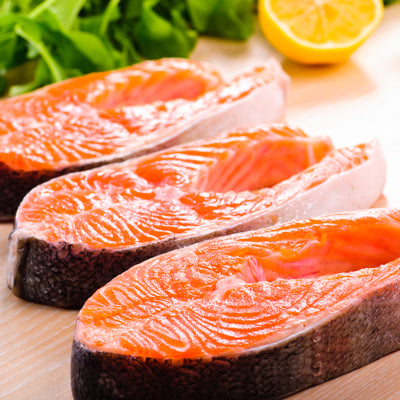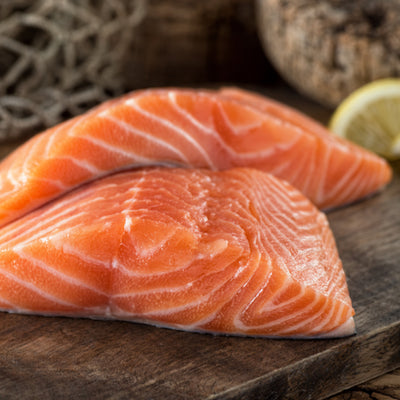Raw Wild Salmon: Risks, Safety Tips & Best Practices

Raw Wild Salmon: Risks & Safety Precautions
Raw wild salmon is a delicacy enjoyed worldwide, especially in sushi, sashimi, and poke bowls. Its buttery texture and rich flavor make it a favorite among seafood lovers. However, consuming raw salmon carries risks, including parasites and bacterial infections.
To safely enjoy raw salmon, it’s crucial to understand the risks and take proper precautions. This guide covers:
✔️ Common parasites & bacteria found in raw salmon.
✔️ Symptoms of infection and food poisoning.
✔️ Safety measures to reduce health risks.
🔗 Shop Safe, High-Quality Wild Salmon:
👉 Buy Sushi-Grade Wild Salmon
Risk of Parasites in Raw Salmon
1. Common Parasites Found in Raw Salmon
Raw salmon may contain microscopic parasites, which can cause serious infections if ingested. These parasites are often found in wild-caught fish and may not be visible to the naked eye.
| Parasite | Description | Health Risks |
|---|---|---|
| Anisakis (Roundworm) | A parasitic worm found in raw fish | Causes anisakiasis, leading to stomach pain, nausea, and vomiting |
| Diphyllobothrium (Fish Tapeworm) | Can grow up to 30 feet in the intestines | Leads to nutrient deficiencies, weight loss, and digestive issues |
| Nanophyetus salmincola | Found in Pacific salmon | May carry bacterial infections, causing fever and diarrhea |
💡 Did You Know? If you use wild salmon for raw consumption, it MUST be deep-frozen to kill parasites and bacteria.
🔗 Shop Sushi-Grade Frozen Salmon for Safety:
👉 Buy Premium Frozen Wild Salmon
2. Symptoms of Parasitic Infections
If you consume raw salmon infected with parasites, symptoms may appear within hours or days and include:
✔️ Persistent stomach pain
✔️ Nausea & vomiting
✔️ Diarrhea & bloating
✔️ Unexpected weight loss
✔️ Fatigue & weakness
Severe cases can lead to intestinal blockage or allergic reactions. Seek medical attention immediately if you experience persistent symptoms after eating raw fish.
Risk of Bacterial Infections in Raw Salmon
1. Common Bacteria in Raw Salmon
Unlike parasites, bacteria are not destroyed by freezing. If salmon is improperly handled or stored, harmful bacteria can multiply, causing food poisoning.
| Bacteria | Source | Symptoms |
|---|---|---|
| Salmonella | Found in contaminated seafood | Fever, diarrhea, abdominal cramps |
| Vibrio | Present in raw shellfish & seawater | Severe stomach pain, vomiting, dehydration |
| Listeria | Grows in improperly stored seafood | Flu-like symptoms, dangerous for pregnant women |
💡 At-Risk Groups: Pregnant women, young children, elderly individuals, and those with weakened immune systems should AVOID eating raw salmon due to health risks.
🔗 Ensure Safe Seafood Handling with High-Quality Salmon:
👉 Shop Fresh & Frozen Wild Salmon
2. Symptoms of Bacterial Food Poisoning
✔️ Fever & chills
✔️ Severe diarrhea & dehydration
✔️ Vomiting & nausea
✔️ Abdominal cramps
Food poisoning can be life-threatening if left untreated. If symptoms persist for more than 48 hours, consult a doctor immediately.
How to Reduce the Risk of Illness from Raw Salmon
1. Buy Sushi-Grade or Previously Frozen Salmon
✔️ Purchase from reputable seafood suppliers that follow strict handling guidelines.
✔️ Look for sushi-grade labels, meaning the fish has been deep-frozen to kill parasites.
✔️ Check the expiration date and buy the freshest salmon possible.
🔗 Shop Safe, Sushi-Grade Salmon:
👉 Buy High-Quality Sushi-Grade Salmon
2. Deep Freezing Kills Parasites
✔️ Freeze salmon at -4°F (-20°C) for at least 7 days before consuming raw.
✔️ Deep-freezing at -31°F (-35°C) for 15 hours kills parasites more effectively.
✔️ NEVER eat fresh-caught wild salmon raw without freezing it first.
💡 WARNING: Even if frozen, wild salmon is NOT recommended for pregnant women, children, or people with weak immune systems.
🔗 Order Frozen Wild Salmon for Safe Raw Consumption:
👉 Buy Flash-Frozen Wild Salmon
3. Proper Storage & Handling
✔️ Refrigerate raw salmon at 40°F (4°C) or below.
✔️ Consume within 1-2 days of purchasing.
✔️ Keep salmon in airtight packaging to avoid cross-contamination.
✔️ Thaw frozen salmon in the refrigerator, NOT at room temperature.
🔗 Shop Fresh Wild Salmon for Safe Home Preparation:
👉 Buy Fresh Wild Salmon Online
4. Cook Salmon for Maximum Safety
✔️ Cook salmon to an internal temperature of 145°F (63°C) to eliminate bacteria.
✔️ Searing or partially cooking the surface reduces contamination risks.
✔️ Ceviche & curing (gravlax) do NOT kill parasites—only freezing does.
💡 Safer Alternative: Try hot-smoked salmon, which is fully cooked and has a delicious, smoky flavor.
🔗 Try Safe, Ready-to-Eat Smoked Salmon:
👉 Buy Hot Smoked Sockeye Salmon
FAQs About Eating Raw Salmon
Q1: Is all wild salmon safe to eat raw?
✅ No. Only previously frozen, sushi-grade wild salmon is safe to eat raw. Fresh-caught wild salmon should be cooked or deep-frozen first.
Q2: Does farmed salmon have parasites?
✅ Farmed salmon is less likely to contain parasites but can still carry bacteria. Always ensure proper handling and freezing.
Q3: How can I tell if raw salmon is fresh?
✅ Look for:
✔️ Bright, firm flesh (no discoloration).
✔️ A mild, ocean-like smell (not overly fishy).
✔️ No slime or excess liquid.
Q4: Can I eat raw salmon if I’m pregnant?
❌ No. Pregnant women should avoid raw salmon due to listeria risks.
Q5: Can lemon juice or vinegar kill parasites?
❌ No. Ceviche-style preparations do not eliminate parasites. Freezing is the only way to kill parasites.
🔗 Buy Safe, Sushi-Grade Wild Salmon:
👉 Order Premium Frozen Wild Salmon
Conclusion: Enjoy Raw Salmon Safely
Raw wild salmon is a delicious, nutrient-rich delicacy, but it comes with risks. To safely enjoy raw salmon:
✔️ Choose sushi-grade or previously frozen salmon.
✔️ Deep freeze at -4°F for 7+ days to kill parasites.
✔️ Buy from trusted seafood suppliers.
✔️ Store properly and consume within 1-2 days.
✔️ Cook salmon to 145°F for maximum safety.
✔️ Avoid raw salmon if you are pregnant, a child, or have a weakened immune system.
🔗 Enjoy High-Quality, Safe Wild Salmon:
👉 Shop Fresh & Frozen Sushi-Grade Salmon
For more seafood safety tips & gourmet recipes, visit Global Seafoods on YouTube.
Also in News

How to Make Sea Bream Sushi With Dry-Aged Tuna & Crab Roll — Step-by-Step With Chef Joshua
A complete guide to making Sea Bream sushi at home, including filleting, curing, slicing, and building a Dry-Aged Tuna & Crab sushi roll. Chef Joshua shares professional tips for restaurant-quality results.

Boiled Crab for Game Night: Everything You Need for a Perfect Seafood Party
Take your game night to the next level with a Boiled crab party. Learn the best recipes, cooking tips, and hosting hacks for a memorable seafood feast.

Boiled Crab for Date Night: A Romantic Guide to the Perfect Seafood Feast
Make your next date night unforgettable with a romantic Boiled crab experience. This guide covers everything you need to know, from ambiance to the best crab varieties.








